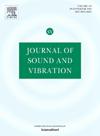Special self-balancing behavior in a self-synchronous system with both vibration utilization and vibration suppression functions
IF 4.3
2区 工程技术
Q1 ACOUSTICS
引用次数: 0
Abstract
In spite of the abundance of literature concerning the synchronization of vibrators, scant attention has been given to effectively solving the vibration dampening of the system through the lens of self-synchronization theory. This paper delves into the realms of synchronization, stability, and self-balancing behavior of a vibrating system with multiple synchronous states driven by four bias vibrators. Utilizing the average method and Hamilton's principle, the synchronization and stability criteria of the four vibrators are deduced. Grounded on the premise of ascertaining whether the theoretical transmission of dynamic loads from the system to the foundation amount to zero, the conditions for self-balancing are explicated. A numerical study unfolds, scrutinizing the effect of bias distance, bias angle, and rotation direction of the vibrator on synchronization states, stability, and self-balancing behavior across varying resonance regions. Some simulations are provided to verify the fidelity of the numerical analyses. Ultimately, the congruence among experimental findings, numerical analyses, and simulation outcomes underscores the soundness of the aforementioned conclusions and methodology employed. These findings indicate that the motion trajectory exhibited in the system in stable states hinges on the synchronization state of the system. Whether propelled by four co-rotating vibrators or counter-rotating counterparts, anchoring the system's operative point in the first sub-resonance region not only can it achieve self-balance effectively but also enables the perfect integration of vibration utilization and vibration suppression without additional vibration isolation strategies.
具有利用振动和抑制振动功能的自同步系统的特殊自平衡行为
尽管关于振子同步的文献很多,但从自同步理论的角度有效解决系统的减振问题却很少有人关注。本文研究了由四个偏置激振器驱动的多同步状态振动系统的同步、稳定和自平衡行为。利用平均法和哈密顿原理,推导了四个振子的同步和稳定性判据。在确定动荷载从系统到基础的理论传递是否为零的前提下,阐述了自平衡的条件。一项数值研究展开,仔细研究了偏置距离,偏置角和振动器的旋转方向对同步状态,稳定性和自平衡行为在不同共振区域的影响。仿真结果验证了数值分析的准确性。最终,实验结果、数值分析和模拟结果之间的一致性强调了上述结论和采用的方法的合理性。这些结果表明,系统在稳定状态下的运动轨迹取决于系统的同步状态。无论是由四个同向旋转振动器推动还是反向旋转振动器推动,将系统的工作点锚定在第一个子共振区域,不仅可以有效地实现自平衡,而且可以实现振动利用和振动抑制的完美结合,而无需额外的隔振策略。
本文章由计算机程序翻译,如有差异,请以英文原文为准。
求助全文
约1分钟内获得全文
求助全文
来源期刊

Journal of Sound and Vibration
工程技术-工程:机械
CiteScore
9.10
自引率
10.60%
发文量
551
审稿时长
69 days
期刊介绍:
The Journal of Sound and Vibration (JSV) is an independent journal devoted to the prompt publication of original papers, both theoretical and experimental, that provide new information on any aspect of sound or vibration. There is an emphasis on fundamental work that has potential for practical application.
JSV was founded and operates on the premise that the subject of sound and vibration requires a journal that publishes papers of a high technical standard across the various subdisciplines, thus facilitating awareness of techniques and discoveries in one area that may be applicable in others.
 求助内容:
求助内容: 应助结果提醒方式:
应助结果提醒方式:


